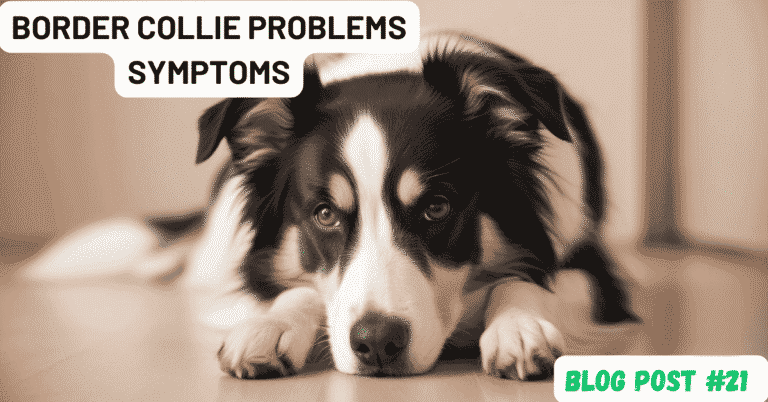By Tom, CCDT-Certified Dog Trainer (10+ Years Border Collie Experience)–With veterinary review by Dr. Emily Harris, DVM (DACVIM)
All dogs have some health symptoms; even border collie problems symptoms are there of this magnificent dog. Border collies are one of the smartest and intelligent dog breeds.
They are famous for their herding skills and strong work ethic. Border Collies combine their physical strength with intelligence, making them a perfect choice for both work and family.
But our favourite breed can also have some health issues. That is why early detection of health issues is necessary to keep our border collie healthy and happy.
Border Collies can often hide their pain because they are able to tolerate high levels of pain. So, it’s very important to keep checking regularly and monitor their health from time to time.
68% of Border Collie health issues stem from undiagnosed genetic conditions – most appear before age 3.
– 2023 OFA Border Collie Health Survey
Contents
- 1 Understanding Border Collie Problems Symptoms
- 1.1 Common Musculoskeletal Disorders
- 1.2 Neurological Issues
- 1.3 Eye Problems And Vision Loss
- 1.4 Hearing Issues
- 1.5 Digestive Issues
- 1.6 Core Health Risks by Life Stage
- 1.7 Behavioral Issues
- 1.8 Coat Care
- 1.9 What eye problems should I watch for in my border collie?
- 1.10 How can I prevent obesity in my border collie?
- 1.11 What are common musculoskeletal disorders in border collies?
- 1.12 What digestive issues are common in border collies?
- 2 Conclusion
Understanding Border Collie Problems Symptoms
Border Collies can face various health issues, which include musculoskeletal conditions, neurological issues, hearing impairments, digestive issues, and challenges they face in weight management.

Additionally, collies can exhibit behavioral issues due to a lack of mental stimulation. Regarding coats they do require some care, but they are not high-maintenance dogs.
Being aware of such potential hazards, a proactive approach can be taken. Making a habit of regular checkups, combined with attentive care, will ensure your collie has a quality life and remains active and enthusiastic.
Common Musculoskeletal Disorders
There are several musculoskeletal conditions that can affect a collie’s life.
Hip Dysplasia
Hip Dysplasia is the most common and genetic condition in Border Collie Problems Symptoms. Hip Dysplasia can occur if the hip joint does not properly fit into the hip socket. It is a genetic condition observed in collies, and other dogs are also prone to this condition.
For Old age dogs, life becomes harder with this condition. Signs one can observe are: major reduction in activity and having difficulty getting up or rising from a lying position. While walking, a dog may limp and can favour one leg, showing bunny-hopping gait when running.
Osteoarthritis
Osteoarthritis is a condition that commonly develops in collies as they age and mostly in those border collies who have had previous joint injuries or even hip dysplasia.
This is a degenerative condition, causing stiffness in joints after rest, unwillingness to jump and climb stairs, major changes in gait movements and patterns, and pain in affected areas when touched.
Treatment with proper diagnosis is pain management medications, physical therapy exercises, supplements for joints, and some minor modifications in exercise routines.
Early detection of this condition can improve treatment outcomes, assisting in maintaining the dog’s mobility. At veterinary screenings, these conditions are detected, and an X-ray and physical examinations help to identify joint problems.
Neurological Issues
Collies are more prone to developing canine epilepsy than any other breed. Neurological disorders can appear between 6 months and 5 years of age, but usually, most of the cases occur during a dog’s adult life.
Signs of seizure can be sudden loss of consciousness, twitching of muscle, limbs getting rigid, mouth foaming, uncontrolled drooling, loss of bowel or bladder control, and disorientation after the episodes.
There are precautions an individual level owner can take, such as to clear the furniture around. Place soft cushions around your dog, and never put your hand near the dog’s mouth. Take a video for veterinary review.
For treatment, anti-epileptic medications which are prescribed by veterinarians.
Going for regular blood monitoring is needed to adjust the dosage of medications and identify and eliminate potential seizure triggers.
With consistent medication schedules, many border collies have been living active lives with epilepsy.
Eye Problems And Vision Loss
There are two primary hereditary eye conditions faced by border collies that impact their quality of life: Progressive Retinal Atrophy(PRA) and Collie Eye Anomaly(CEA)
Let’s discuss Progressive Retinal Atrophy(PRA)
It starts with night blindness and then gradual deterioration of retinal cells. PRA happens mostly between 3-5 years of age and then complete vision loss within 1-2 years of onset.
Now, Collie Eye Anomaly(CEA)
CEA can be present at birth, affecting the development of the choroid layer. The severity varies from mild vision impairment to complete blindness. But these CEA can be detected in early puppy screening.
Signs a dog having PRA OR CEA can be constantly bumping into furniture and walls, hesitation to move in dim lights, cloudy eye appearance, excessive tearing, redness around eyes, frequent blinking. Unfortunately, there is no cure for PRA or CEA. Early detection and environmental modification with training adjustments can be done.

Hearing Issues
The next issue in Border Collie Problems Symptoms is Hearing Issues. Collies having merle coat face a higher risk of congenital deafness due to genetic factors affecting inner ear development.
In this, the merle gene impacts the development of melanocyte cells, which is responsible for both coat colour and inner ear function. The dog is almost deaf to verbal commands and displays startled reactions when gets approached from behind.
Other signs are loud barking, heavy sleeping, more dependency on visual cues, and difficulty locating the sources of the sound. This deafness can affect a single ear or both. Dogs with double merle coats are more affected by bilateral deafness.
Early detection with BAER(Brainstem Auditory Evoked Response) testing assists in identifying hearing impairments in puppies.
The treatment or solution is teaching hand signals, using vibration caller for communication and visual boundary markers, having consistent routines, and enhancing environmental awareness trainings.
Digestive Issues
Nowadays, border collies are facing weight issues. There are collies showing obesity due to changes in lifestyle. Collies in urban areas and apartments are majorly facing obesity because their natural herding activities are restricted in small spaces.
The most common reasons for weight gain are excessive treats and table scraps. Owners often serve more food to the dogs out of love and care, and also they don’t bother to understand nutritional needs or misunderstand the requirements.
Lack of daily exercise is a concerning factor. Weight gain puts pressure on joints, leading to arthritis. Fat dogs have difficulty breathing and are at risk of heart disease. Less food serving and lot of exercises with agility training can help in weight loss.
Core Health Risks by Life Stage
Puppies (0-12 Months)
🔼 Collie Eye Anomaly
- Symptoms: Bumping into walls, cloudy pupils
- Test: CERF eye exam ($85) at 10 weeks
🔼 Neuronal Ceroid Lipofuscinosis
- Symptoms: Circling, seizures starting at 6mo
- DNA Test: Wisdom Panel ($160)
Luna’s NCL was caught early through breeder testing – she’s now 5 and symptom-free on specialized meds.
Adults (1-7 Years)
The Herding Breed Triad
| Condition | Early Signs | Emergency Signals |
| Hip Dysplasia | “Bunny hopping” gait | Can’t rise from nap |
| Epilepsy | Lip smacking at rest | >2 seizures/day |
| Allergies | Paw licking >1hr/day | Facial swelling |
Border Collies often hide pain – film suspicious behavior for your vet.
Seniors (8+ Years)
🔼 Degenerative Myelopathy
- First symptom: Knuckling hind paws
- DNA test available (50% carriers)
🔼 Cognitive Decline
- Nighttime pacing
- Staring at walls
Behavioral Issues
Normal vs. Problematic
| Behavior | Normal | Vet Visit Needed |
| Herding kids | ✅ | ❌ (with training) |
| Shadow chasing | ❌ | ✅ (OCD indicator) |
| Tail chasing | ❌ | ✅ (Pain signal) |
Behavioral Problems in collies are directly related to lack of stimulation. These intelligent, smart dogs thrive on work, they badly need exercise and mental stimulation to lead a normal, free life.
People hardly recognize the needs of collies and are unable to provide all the exercises and time. The result is the destructive behavior of border collie.
These dogs end up digging holes in backyards and parks, damage furniture and other household items by chewing, keep barking endlessly, show shadow obsession, and herd children out of the house.
Puzzle toys and interactive games assist in mental stimulation, and daily 2 hours of exercise is good.
Drug-Free Solution:
For obsessive behaviors, try 10-minute ‘find it’ scent games 3x/day before meds.
Coat Care
The last topic in Border Collie Problems Symptoms is coat care. Ignoring coat care is not in the best interest of either the dog or the owner.
Common skin issues that can arise is hot spots, they are red and moist areas caused by excessive licking. Others are some allergic reactions and dermatitis.
Take up brushing 2-3 times a week using a slicker brush. During shedding seasons, try brushing with an undercoat rake. Good dog shampoo use is recommended.
What eye problems should I watch for in my border collie?
Collies are prone to Progressive Retinal Atrophy and Collie Eye Anomaly. PRA can cause vision loss, and CEA affects eye development.
How can I prevent obesity in my border collie?
Daily 2 hours of exercises with some agility training and less food serving.
What are common musculoskeletal disorders in border collies?
Musculoskeletal disorders are hip dysplasia and osteoarthritis, mostly seen in old dogs.
What digestive issues are common in border collies?
Vomiting and diarrhea due to food intolerances or infections.
Conclusion
A Border Collie owner must be proactive with the dog’s health and understanding. You can do regular veterinary check-ups and constantly monitor for physical symptoms while simultaneously keeping health records.
Any dog can happily thrive with proper care and nurture. But with collies, you’ll have to take care of both their physical and mental well-being. Recognizing symptoms early can assist in laying proper groundwork for a happy life.
Hope you have liked this Border Collie Problems Symptoms article and may it benefit you.

